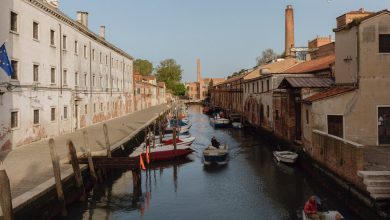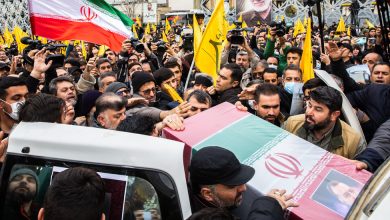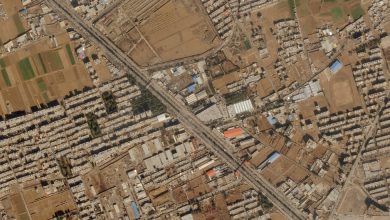What’s Next for California’s Last Nuclear Power Plant


Facing possible electricity shortages, Gov. Gavin Newsom said the Diablo Canyon Power Plant might continue operating beyond its planned closing.Credit…Mark Ralston/Agence France-Presse — Getty Images
Along California’s picturesque Central Coast, on a bluff overlooking the ocean, looms the Diablo Canyon Power Plant, the state’s single largest source of electricity.
The plan has long been to shut down the facility by 2025, the result of a deal struck in 2016 between its owner, Pacific Gas & Electric, and environmental and labor groups. The nuclear plant has been dogged by concerns about nearby fault lines and radioactive waste, and its closure was intended to push California toward relying more on renewable energy sources.
But that timeline now appears to be in flux. Amid concerns about meeting California’s energy demands, particularly during increasingly hot summers, Gov. Gavin Newsom said last month that he wanted to seek federal funding to keep the plant running beyond 2025. The proposal has inflamed decades-old tensions around California’s sole remaining nuclear power plant.
“Your suggestion to extend the operational life of the Diablo Canyon nuclear facility is an outrage,” dozens of environmental and antinuclear organizations wrote in a letter to Newsom this week. “Diablo Canyon is dangerous, dirty and expensive. It must retire as planned.”
Newsom has no direct authority over the plant, so its owner, PG&E, would have to request a share of the $6 billion recently made available by the Biden administration. The deadline to apply for the funds was originally this week, but federal officials just postponed it until July.
A PG&E spokeswoman, Suzanne Hosn, said on Thursday that the agency was open to exploring different options “if the state determines Diablo Canyon is needed” to keep its energy grid reliable. PG&E would likely need approval from state and federal regulators to prolong the life of its nuclear reactors.
“The extension is giving us more time to review and evaluate the application criteria and the process,” Hosn told me. “We’re seeing whether and how Diablo fits into the funding opportunity should the state want to move forward.”
Built near Avila Beach in San Luis Obispo County, Diablo Canyon first went online in 1985 during an era of heavy opposition to nuclear power. A young Jerry Brown, serving his first stint as governor, protested the facility years before it opened. There had been a partial meltdown of a nuclear reactor in Pennsylvania in 1979, and then, in 1986, the infamous Chernobyl disaster.
But Californians’ views toward nuclear energy have shifted over the past few decades.
Nuclear power isn’t a renewable energy source like solar or wind power, but it is emissions-free, meaning it doesn’t produce the greenhouse gases that contribute to global warming. In the U.S., half of our carbon-free energy comes from nuclear reactors.
So, as fires and heat waves worsen in the Golden State, concerns about climate change appear to be “leading Californians to reconsider some of their long-held views about nuclear power,” said Eric Schickler, co-director of the U.C. Berkeley Institute of Governmental Studies.
In a poll conducted by the institute last month, 44 percent of Californians surveyed said they supported building more nuclear plants in the state, compared with 37 percent who were against. Thirty-nine percent opposed closing Diablo Canyon, while 33 percent were for the move.
As for Newsom: He wants to close Diablo eventually, but “supports keeping all options on the table” for the time being, his spokeswoman Erin Mellon told me on Thursday.
“This includes considering applying for federal funding for a possible limited term extension to Diablo Canyon, which continues to be an important resource as we transition to clean energy,” Mellon said in an email.
But Ralph Cavanagh, co-director of the energy program at the Natural Resources Defense Council, said he didn’t think the Diablo Canyon plant would even be eligible for the federal funds.
The money is intended for nuclear plants that, unlike Diablo Canyon, are shutting down because they are operating at a loss, he said. The Diablo closure plan, which the N.R.D.C. was involved in, came about because the plant required such massive refurbishments that it became cheaper for PG&E to invest instead in alternative energy sources.
And that’s always been the plan, Cavanagh emphasized: to replace Diablo Canyon energy with more environmentally-friendly sources. Closing the plant’s doors in 2025 shouldn’t stress the state’s electricity supplies, he said.
“The governor’s concern about system reliability is totally understandable, but it was very much part of the planning for the retirement and replacement of Diablo Canyon,” Cavanagh told me. “This is a decision that, from our perspective, has been made. It’s not an open case.”
If you read one story, make it this
Fentanyl tainted pills bought on TikTok, Snapchat and other apps are causing drug deaths to soar.
“Social media is almost exclusively the way they get the pills,” said Morgan Gire, the district attorney for Placer County, where 40 people died from fentanyl poisoning last year.
The rest of the news
-
Gender diversity law: California will appeal a ruling that struck down a law requiring public companies to have women on their boards of directors.
-
Can’t qualify for in-state tuition: Gaps in California law mean that some undocumented students and visa holders don’t get in-state tuition, even if they have lived in the state for more than a decade, CalMatters reports.
-
Voting guidance: Here’s what Californians should do if a candidate they have already voted for withdraws from the race, LAist reports.
-
Guns on sets: New rules about using guns while filming failed to pass the California Legislature on Thursday, The Associated Press reports.
SOUTHERN CALIFORNIA
-
Homelessness in San Diego: Results of the first homeless count in two years found that the number of people without shelter had increased 9 percent in the city of San Diego, The Los Angeles Times reports.
CENTRAL CALIFORNIA
-
Arsonist sentenced: The man responsible for starting a fire that killed 12 California condors and seriously injured a firefighter was sentenced to 24 years in prison.
-
First Native American federal judge: Sunshine Suzanne Sykes, a member of the Navajo Nation, will be California’s first Native American federal judge, Fox 40 reports.
NORTHERN CALIFORNIA
-
Power outage: A power outage in the Sacramento Municipal Utility District on Thursday affected 650 customers and delayed the start of California’s Legislature, The Associated Press reports.
What we’re eating
An easy white bean and avocado salad.
Where we’re traveling
What to eat, drink and see in Los Angeles this summer.
What we’re reading
A tale of murder, deceit and the birth of Stanford University.
Tell us
What do you want to know about California’s June primary election? Email us your questions at [email protected].
And before you go, some good news
Starting tomorrow, San Diegans visiting their neighborhood parks will find not just fresh air and solace, per usual, but also a series of innovative art projects.
A city initiative known as Park Social invited local artists to transform open spaces in 28 public parks, including spaces within canyons and along the shoreline, The Los Angeles Times reports.
The art installations will be officially unveiled on Saturday and on view until Nov. 20. All are free to visit.
The goal is to reconnect the community with natural spaces after years of pandemic isolation, said Christine Jones, chief of civic arts strategies for San Diego.
“This is about bringing people together and celebrating art and parks,” Jones told The Los Angeles Times. “Reconnecting and celebrating.”
Thanks for reading. I’ll be back on Monday. Enjoy your weekend. — Soumya
P.S. Here’s today’s Mini Crossword, and a clue: They sense scents (5 letters).
Briana Scalia and Mariel Wamsley contributed to California Today. You can reach the team at [email protected].
.




